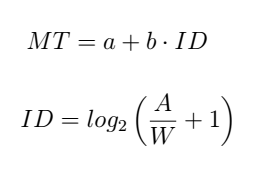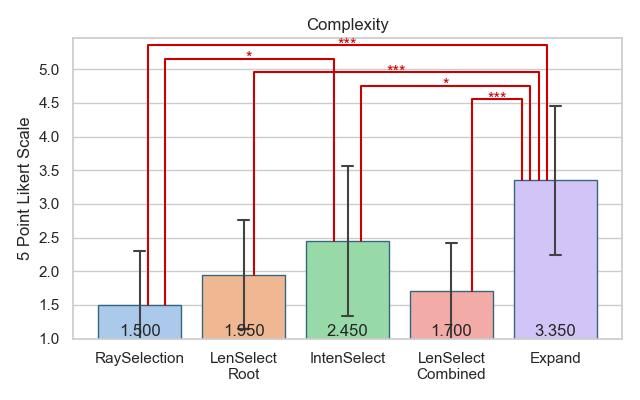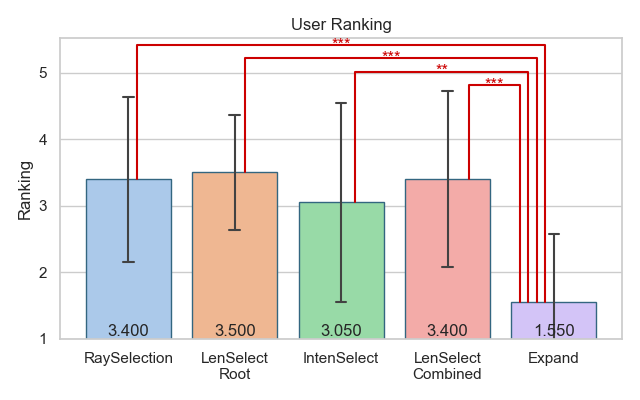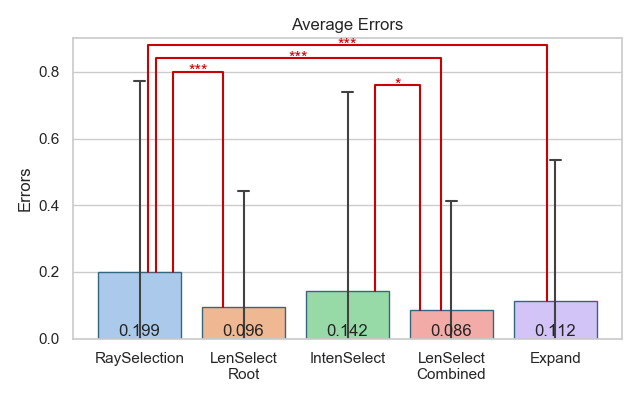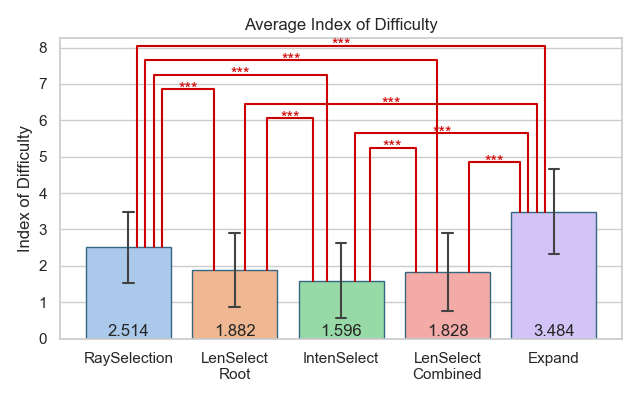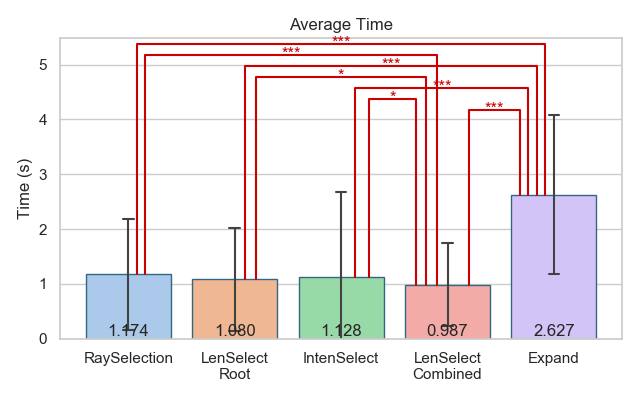LenSelect - A Novel Selection Technique for 3D Selection
In this thesis LenSelect, a novel selection metaphor based on scaling up objects for easier selection,
is discussed and evaluated against other state-of-the-art selection techniques.
These techniques were compared in their efficiency (task completion time, selection errors, generated Index of Difficulty according to Fitts' Law),
as well as from a usability stand point according to the QUESI questionnaire.
The shown thesis builds upon Florian Rohde's bachelor thesis.
Description
LenSelect is based on an observation of Fitts' Law, which states that the time needed to make a selection depeneds on the distance of
the selection pointer to the object and the width of the object in movement direction of said pointer. LenSelect increases the width
by increasing the size of the object, therefore making selection easier and faster.
Throughout the years a variety of different selection techniques was invented for different use-cases and to approach different problems.
Research has shown that there is no superior selection for all situations. Selection depends on the specific requirements of the task,
the layout of the environment and experiences and preferences of the user.
Even though the proposed test scenarios are supposed to cover all use-cases, environments with high overlap of objects, so-called cluttered environemnts and
the selection of far away objects were examined in particular.
In a prestudy different scaling functions were evaluated against each other and the most promising two selected for the final study.
These were compared to a simple raycast, as well as IntenSelect (Haan, G., Koutek, M., and Post, F., 2005) and Expand
(Cashion J., Wingrave C., and LaViola Jr. J., 2012).
The project was implemented in Unreal Engine 4.21.2 and evaluated with the HTC Vive Pro, as well as the Powerwall.
Fitts' Law
Fitts' Law describes the time needed for a selection based on the pointer's distcance to the target and the target's width in movement direction of the pointer.
With a the intercept and b the slope for the given selection technique (usually derived through regression).
ID the Index of Difficulty, describing how difficult a given selection is. A the pointer's distance to the target and W the target width.
Test Scenarios
The different test scenarios used for evaluating the selection techniques:
Results
Consider that lower values are better, except for the QUESI Total and User Ranking, where higher values are better.
In addtion variance analysis was used to determine if the found results differed significantly. If a significant difference was
found between groups they are connected by red lines.
The stars above those lines show the significance level:
- * if p <= 0.05 and p > 0.01
- ** if p <= 0.01 and p > 0.001
- *** if p < 0.001
Vive
Fitts' Data
Questionnaire Data
Powerwall
Fitts' Data
Questionnaire Data
Conclusion
As can be seen Expand performs worse than the other techniques in almost all scales, except for average selection errors.
Meanwhile IntenSelect generally produces a lower Index of Difficulty, but fails to capitalize on this advantage in the task completion time scale.
There LenSelect Combined shows to perform best of all selection techniques, if only slightly compared to most other selection techniques.
Overall both LenSelect techniques perform either better or on par with RaySelection and can keep up with IntenSelect. This applies to both the Powerwall,
as well as the HTC Vive.
According to participants LenSelect feels about as or slightly more complex than RaySelection. The same can be said for the QUESI Total.
Both LenSelect techniques are well received by participants rating about as high as RaySelection or slightly higher or, in case of the Powerwall, significantly
higher than IntenSelect.
Overall LenSelect's performance is on par with that of IntenSelect while being preferred over IntenSelect in the questionnaire scales.
It must be said however that performance and user satisfaction vary highly between test scenarios. However either a LenSelect technique or IntenSelect
score highest in any test scenario.
A further refinement of the scaling function for LenSelect could lead to a better performance than any other technique in this thesis.
Files
A full version of the master's thesis can be downloaded here (English only).
Demo Video of LenSelect with the HTC Vive:

Demo Video of LenSelect with the Powerwall:
(Note that the lens cone is invisible in this version)
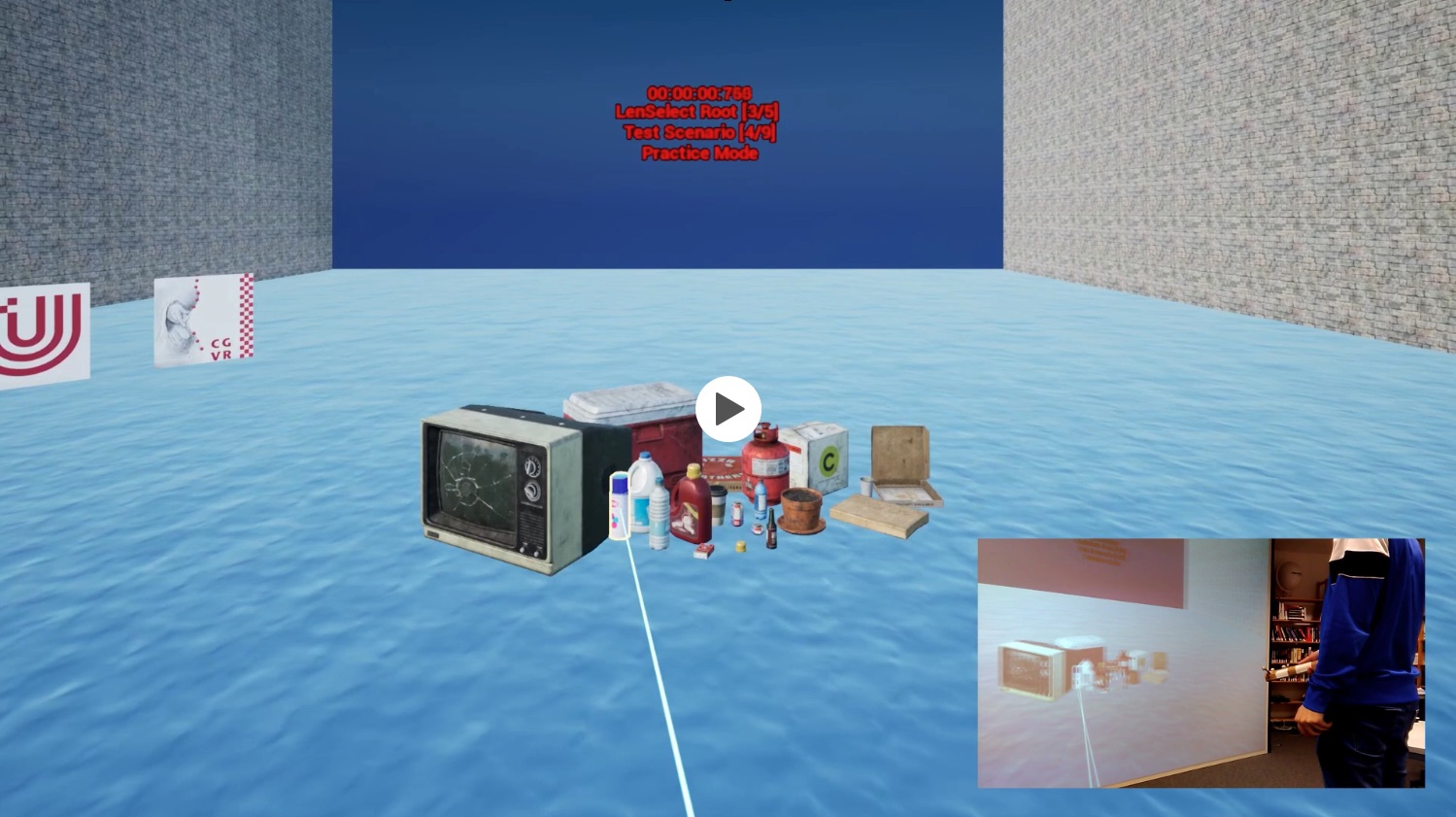
License
This original work is copyright by University of Bremen.
Any software of this work is covered by the European Union Public Licence v1.2.
To view a copy of this license, visit
eur-lex.europa.eu.
The Thesis provided above (as PDF file) is licensed under Attribution-NonCommercial-NoDerivatives 4.0 International.
Any other assets (3D models, movies, documents, etc.) are covered by the
Creative Commons Attribution-NonCommercial-ShareAlike 4.0 International License.
To view a copy of this license, visit
creativecommons.org.
If you use any of the assets or software to produce a publication,
then you must give credit and put a reference in your publication.
If you would like to use our software in proprietary software,
you can obtain an exception from the above license (aka. dual licensing).
Please contact zach at cs.uni-bremen dot de.
If you use any of the assets or software from this web page to produce a publication, you must give credit and put a reference in your publication. For the reference, please use the following format:
Waldemar Wegele. "LenSelect - Dynamic Object Scaling in Virtual Environments for Object Selection". Master's Thesis, University of Bremen, August 2020.




